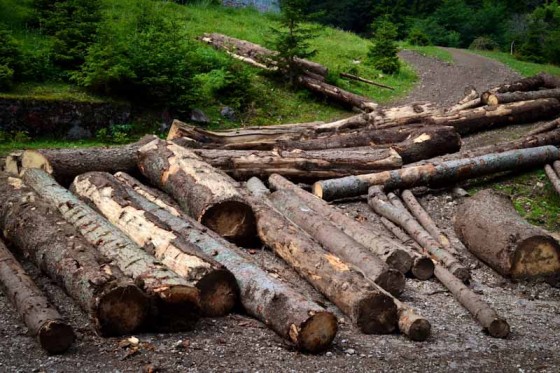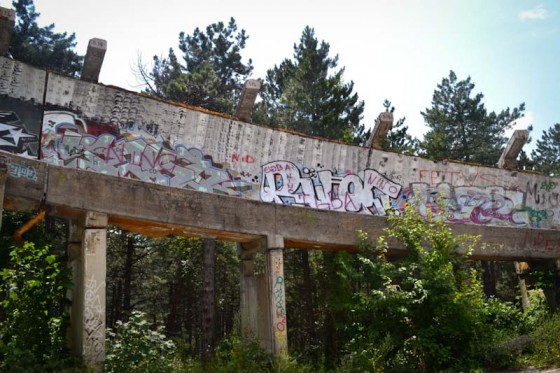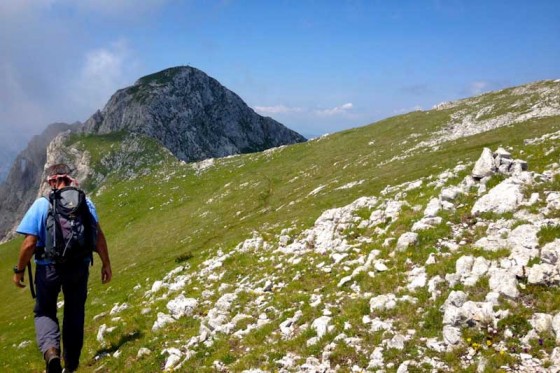In a conflict familiar to Washingtonians, Bosnian conservationists and loggers are at odds. But many of the country’s forests are shielded by a secret weapon.
Protecting the forests of Bosnia and Herzegovina does not take lobbyists or preservation societies. It takes land mines.
 I stared blankly at my hiking guide, Fikret Kahrovic, as our car rocked over the gravel mountain road, trying to follow his explanation. Seconds later he was tapping my shoulder, gesturing out the window, pointing out our peak in the distance..
I stared blankly at my hiking guide, Fikret Kahrovic, as our car rocked over the gravel mountain road, trying to follow his explanation. Seconds later he was tapping my shoulder, gesturing out the window, pointing out our peak in the distance..
Bureaucracy can be a slow beast everywhere, but especially in Bosnia. The 1995 Dayton Peace Accords ended a brutal war and created a multi-ethnic democratic government. Three Presidents, one Bosniak, one Croat and one Serb share a four-year term, rotating power every eight months. Gridlock is commonplace.
During the war in the early Nineties, landmines were used to secure borders and restrict movement. According to the Bosnia-Herzegovina Mine Action Committee there are still 200,000 active mines and almost 10,000 minefields covering 2.5 percent of the country.
As we started our hike, Kahrovic told me to walk ahead. It became a running joke that I would check the trail for mines and also be sacrificed to any bears we might encounter.
It was just a joke; Kahrovic, who spent 30 years in the mountain rescue service, knows the hills of Bosnia well — and says he would never take a group somewhere risky.
“One thing is true about Bosnia,” he said with a laugh. “It’s never boring!”
 The road from Sarajevo to Belgrade, reminiscent of Pacific Northwest mountain highways. (Photo by Anna Callaghan)
The road from Sarajevo to Belgrade, reminiscent of Pacific Northwest mountain highways. (Photo by Anna Callaghan)
He’s right about that.
The most beautiful hiking is on Treskavica, he said, though he hesitates to mention it because most of the mountain is heavily mined.
This was a depressing realization: that people are surrounded by such beauty and unable to enjoy it with unabated freedom. I was spoiled to have grown up in the Pacific Northwest, and I took for granted the ability to explore without worrying about my next step.
The city of Sarajevo is a narrowly squeezed into a valley surrounded by hills. It remained under siege during the war, and those mountains, once revered, became the city’s prison gates.
The unnatural tree line, the former front-line, is a reminder of that. The tree-topped hills held Serb trenches that were lined with mines. Below that, parts of the hills are bare from when the opposition would push high enough to allow people to gather wood during cold winters. The space between was no man’s land.
Forests around the country, like those on Trescavica, are preserved in a way by landmines. Clearing mines is an expensive and arduous process. “The forest there will never be logged because there are too many mines,” said Kahrovic.
On a number of other hikes we took around the country, the evidence of logging was apparent: bare hillsides dotted with stumps, yellow tractors perched on the road, and trees tagged with markers indicating they should be removed.
“The next time you hike here,” said Kahrovic. “It won’t look the same.”
Bosnia is one of the poorest countries in Europe and struggles with corruption. Logging is fast and easy money. After the war, criminal groups took advantage of the lack of regulations, and the effectiveness of bribing officials. Bosnia’s two national parks are protected by law, but illegal logging is still a problem.
 Cleared logs on the road up Mount Trebevic. (Photo by Anna Callaghan)
Cleared logs on the road up Mount Trebevic. (Photo by Anna Callaghan)
According to a 2011 report, 53 percent of the country is forested and the industry accounts for 11 percent of total exports. Those statistics both welcome foreign investment for logging and motivate conservationists to push to save it. The question becomes: is preserving nature more important than a profitable logging industry? Or is there room for both?
In Washington, like in Bosnia, there was a historic tension between logging companies and conservationists, and that tension still exists at different levels in both nations today.
The initial timber industry in Washington was catalyzed by the California Gold Rush in 1848 and continued to expand, partly due to new technologies and a new railroad. In the 1870s Washington battled with corruption after Hazard Stevens, the son of the state’s first governor, was accused of taking bribes.
In 1891 the federal government passed a law to help conserve the nation’s forest resources, and set aside land that included 1.5 million acres for a forest reserve on the Olympic Peninsula, which became Olympic National Park. Mount Rainier National Park was created in 1899 and in 1968 environmentalists helped create North Cascades National Park. After WWII the logging industry, weakened by the Great Depression, became less important to the state economy, and the environmental movement spurred efforts to protect the state’s forests.
Mount Maglic, though dwarfed by Rainier, is Bosnia’s highest peak. Its name means “fog,” but we happened to be there on a rare clear day. In discussing the weather another hiker repeated something I heard while sitting at Camp Muir, on Mount Rainier: “If you don’t like the weather, wait five minutes.”
We traversed open meadows dotted with lingering snowpack and closed-in forests; we wound up switchbacks and scaled rock faces using steel cables. After a few false summits we stood on top, able to clearly see the surrounding peaks in both Bosnia and Montenegro. Other hikers were sprawled out, resting their legs under the sun, sharing stories and food with whomever they happened to be sitting near.
 The deteriorated bobsled course from the 1984 Olympic Games, on Mount Trebevic. (Photo by Anna Callaghan)
The deteriorated bobsled course from the 1984 Olympic Games, on Mount Trebevic. (Photo by Anna Callaghan)
In 1984 the country (then Yugoslavia) showed off its beauty as it welcomed the world to Sarajevo for the Winter Olympic Games, where local Washington legends Debbie Armstrong, Phil and Steve Mahre, and Rosalynn Sumners all stood atop the podium.
Both Bosnia and the Pacific Northwest are recreational hotspots, home to scraggly mountain peaks, rivers and lakes. The difference is that while people equate the Pacific Northwest with beautiful nature, it’s is not uncommon for people to think of Bosnia as a warring nation still cloaked in a grey fog, even though the war finished almost twenty years ago, and Bosnia, like Washington, is one of the greenest place I’ve ever seen.
There have been more recent efforts to raise awareness about the environment. Groups like Green Visions organize adventure travel and focus on eco-tourism and environmental protection.
It’s a start, but in the long term it will be interesting to see if Bosnia follows the same trajectory as the Pacific Northwest: Will the appreciation of natural resources become a strong enough subculture to counter a powerful logging industry?
In the meantime, the best way to protect Bosnia’s natural beauty may still be with land mines.


